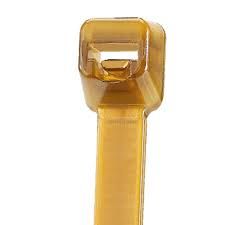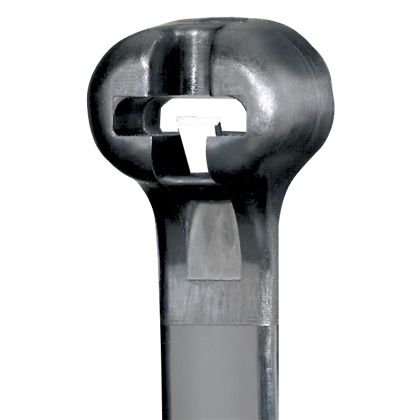Deep-sea environments present some of the most extreme conditions for equipment and materials. The combination of high water pressure, saltwater corrosion, extreme temperatures, and biofouling makes it essential to use durable, high-performance cable ties for securing cables, pipelines, and underwater structures.
Many traditional cable tie materials, including nylon and even standard stainless steel, struggle to endure prolonged exposure to the deep sea.
PEEK (Polyether Ether Ketone) cable ties provide the ultimate solution due to their exceptional chemical resistance, extreme pressure endurance, and high-temperature stability.
This article explores the challenges of deep-sea environments, why PEEK cable ties are the best choice, and the best practices for installation and maintenance.
Challenges of Cable Management in Deep-Sea Environments
Deep-sea applications require cable ties that can withstand:
1. Extreme Water Pressure
- At depths of 6,000 meters (20,000 feet) or more, pressures exceed 8,700 psi (600 bar).
- Most plastic cable ties collapse or lose structural integrity under such forces.
- PEEK cable ties retain their strength and flexibility even under these conditions.
2. Saltwater Corrosion
- Continuous exposure to high salinity accelerates corrosion in most metals, including some grades of stainless steel.
-
PEEK is inherently resistant to saltwater and does not degrade over time.
3. Extreme Temperature Variations
- Deep-sea equipment can experience temperatures from -60°C (-76°F) in deep-sea currents to over 250°C (482°F) in geothermal vent areas.
- Most plastics become brittle in cold temperatures, while PEEK maintains flexibility.
4. Chemical Resistance
- Deep-sea environments expose materials to hydrocarbons, methane, hydrogen sulfide, and other chemicals from underwater geological activity.
- PEEK remains chemically stable and does not react with harsh substances.
5. Biofouling and Marine Growth
- Underwater structures accumulate algae, barnacles, and other marine life, which can weaken or dislodge conventional cable ties.
- PEEK resists biofouling, ensuring long-term performance without degradation.
Why PEEK Cable Ties Are the Best Choice for Deep-Sea Environments
PEEK cable ties outperform other materials in deep-sea conditions due to their:
1. Exceptional Strength and Pressure Resistance
- PEEK has a tensile strength of up to 150 lbs (68 kg), making it one of the strongest non-metallic cable tie materials.
- It maintains its integrity under extreme pressure, unlike traditional plastics that deform or break.
2. Superior Saltwater and Chemical Resistance
- PEEK is 100% resistant to saltwater corrosion.
- It withstands oil, gas, and aggressive chemicals commonly found in deep-sea drilling and exploration.
3. Wide Temperature Endurance
- PEEK operates effectively in temperatures from -60°C (-76°F) to 260°C (500°F).
- Unlike nylon, which becomes brittle in cold conditions, PEEK remains stable and flexible.
4. Non-Conductive and Electrically Insulating
- In deep-sea applications, electrical insulation is critical for subsea communication cables and power lines.
- PEEK does not conduct electricity, reducing the risk of interference or electrical shorts.
5. Low Water Absorption and Biofouling Resistance
- Unlike nylon, which absorbs water and weakens over time, PEEK maintains its original strength and shape.
- It resists marine growth, preventing unnecessary drag or entanglement in underwater structures.
Best for Extreme Conditions: Panduit PEEK Pan-Ty® Cable Ties

The
Panduit PEEK Pan-Ty® Cable Ties are engineered for high-temperature, chemical-resistant, and radiation-exposed environments. Made from polyetheretherketone (PEEK), these ties provide exceptional strength and durability, maintaining performance even under extreme conditions.
Unmatched Heat and Chemical Resistance
Designed for continuous use in temperatures up to 500°F (260°C), these ties outperform standard plastic options in high-heat applications. Their exceptional chemical resistance ensures they withstand exposure to organic and inorganic chemicals, making them ideal for oil and gas, aerospace, and automotive industries.
Radiation and Flame Resistance
PEEK material meets MIL-P-46183 specifications and is approved for use by the Department of Defense. These ties resist high levels of gamma radiation, ensuring long-term durability in nuclear and aerospace applications. Their UL 94V-0 flammability rating ensures low smoke and toxicity, making them safe for confined or sensitive environments.
Designed for Strength and Reliability
With a one-piece construction, these cable ties provide consistent performance and low threading force, making installation easier. Their high tensile strength guarantees secure bundling of cables, even in high-vibration or extreme conditions.
Ideal Applications
These cable ties are perfect for
demanding industries requiring high-performance fastening solutions:
-
Oil and Gas: Resistant to corrosive chemicals and extreme heat.
-
Aerospace: Approved for military and aviation applications.
-
Automotive: Withstands heat and harsh fluids in engine compartments.
-
Nuclear and Industrial Facilities: Durable under radiation and chemical exposure.
For professionals needing reliable, high-performance cable management, Panduit PEEK Pan-Ty® Cable Ties provide an unmatched combination of strength, chemical resistance, and temperature stability.
Learn more: The Best Cable Tie for High-Pressure Applications: Coated Stainless Steel Cable Ties
Best Applications for PEEK Cable Ties in Deep-Sea Environments
1. Subsea Communication and Power Cables
- Used to secure fiber optic and electrical cables running across the ocean floor.
- Maintains strength despite exposure to high-pressure environments.
2. Offshore Oil and Gas Operations
- Essential for securing cables and piping on offshore drilling rigs and deep-sea oil platforms.
- Resistant to chemicals such as crude oil, hydraulic fluids, and drilling byproducts.
3. Underwater Research Equipment
- Used in autonomous underwater vehicles (AUVs), remotely operated vehicles (ROVs), and deep-sea sensors.
- Ensures cables and equipment remain secure despite rapid pressure changes.
4. Military and Defense Applications
- Critical for underwater surveillance, naval cables, and defense sensor networks.
- Ensures reliability in high-risk deep-sea operations.
5. Marine Renewable Energy Systems
- Secures cables in underwater tidal turbines and floating offshore wind farms.
- Resists harsh marine conditions while ensuring reliable energy transmission.
Installation Best Practices for PEEK Cable Ties

1. Use the Correct Tensioning Tools
- Applying too much tension can damage cables, while too little can cause slippage.
- A specialized PEEK cable tie tensioning tool ensures optimal tightness.
2. Secure Ties at Stable Attachment Points
- Attach cable ties to reinforced structures to minimize movement from water currents.
- Avoid areas with excessive flexing to prevent mechanical stress.
3. Regularly Inspect for Biofouling
- While PEEK resists marine growth, periodic inspections help ensure no buildup affects performance.
- In extreme cases, anti-fouling coatings can be applied to additional components.
4. Avoid Overloading Cable Bundles
- Overloading increases stress on cable ties, reducing longevity.
- Use multiple ties for large-diameter cable bundles to distribute pressure evenly.
5. Monitor Long-Term Performance
- While PEEK cable ties have a lifespan exceeding 20 years, regular monitoring ensures continued reliability.
- Replace any worn or damaged ties as part of routine deep-sea maintenance.
Comparing PEEK Cable Ties to Other Deep-Sea Materials
| Cable Tie Type |
Tensile Strength |
Temperature Resistance |
Saltwater Resistance |
Chemical Resistance |
Best Use Cases |
| Standard Nylon |
Low (50 lbs) |
-40°C to 85°C |
Poor |
Poor |
General indoor use |
| UV-Resistant Nylon |
Medium (75 lbs) |
-40°C to 105°C |
Moderate |
Moderate |
Outdoor wiring |
| Stainless Steel (316) |
High (250 lbs) |
-80°C to 538°C |
High |
High |
Offshore and industrial use |
| PEEK |
Very High (150+ lbs) |
-60°C to 260°C |
Very High |
Very High |
Deep-sea, subsea cabling, offshore oil and gas |
Wrapping Up
Deep-sea environments pose extreme challenges, from high pressure to chemical exposure and saltwater corrosion. PEEK cable ties offer unmatched strength, durability, and resistance to environmental hazards, making them the best choice for securing cables and equipment in subsea operations.
By investing in
PEEK cable ties, industries involved in offshore oil and gas, subsea communication, underwater research, and renewable marine energy can ensure long-term reliability, reduced maintenance, and enhanced operational efficiency in the harshest conditions on Earth.
For more insights and tips on cable ties and other related products, explore
cabletiesunlimited.com and follow us on our social media communities on
Facebook and
Instagram!
 The Panduit PEEK Pan-Ty® Cable Ties are engineered for high-temperature, chemical-resistant, and radiation-exposed environments. Made from polyetheretherketone (PEEK), these ties provide exceptional strength and durability, maintaining performance even under extreme conditions.
The Panduit PEEK Pan-Ty® Cable Ties are engineered for high-temperature, chemical-resistant, and radiation-exposed environments. Made from polyetheretherketone (PEEK), these ties provide exceptional strength and durability, maintaining performance even under extreme conditions.

